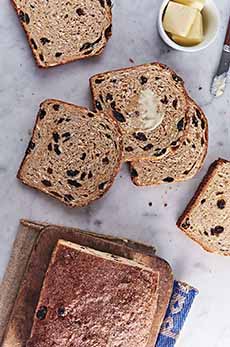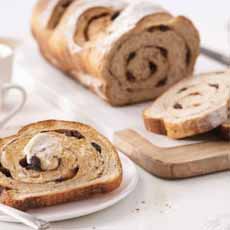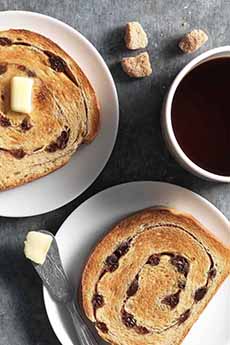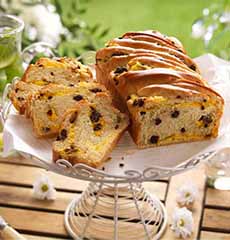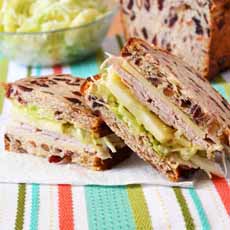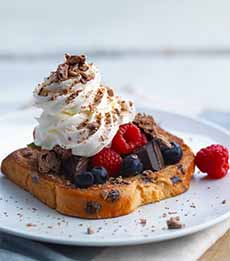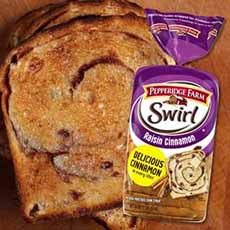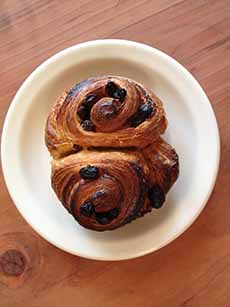Cinnamon Raisin Bread Recipe For National Raisin Bread Month
|
|
We grew up on raisin bread: raisin bread toast at breakfast with melting butter, raisin bread French toast with maple syrup on the weekends. For lunch, cream cheese raisin bread sandwiches, chicken salad with apples and cashews on raisin bread, or peanut butter or Nutella on raisin bread, grilled cheese or ham and cheese with Brie or Gruyère. Raisin bread pudding for dessert. Often Mom added chopped walnuts to the cream cheese. And then there was bread pudding. November is National Raisin Bread Month, and we’re waxing nostalgic. Cheese. As an adult, we’ve expanded our repertoire. We serve quartered slices toasted, with a cheese plate. We make raisin bread panini with goat cheese, cream cheese or mascarpone, and raspberry jam. Dessert. If you bake a loaf, you can cut thick slices and toast them, and serve them like toasted pound cake, topped with vanilla ice cream, caramel sauce, and toasted pecans (photo #6). You can also serve those toast points with chocolate fondue. Salad. You can cut and butter thick-sliced raisin bread, cut them into crouton cubes, and bake them in the oven (about 20 to 25 minutes at 375°F). Then, add them to a green salad with goat cheese, apples, beets, and toasted pecans—that is, if you haven’t already munched them all before they’ve even cooled. Panzanella. You can make raisin bread panzanella (bread salad), although we’d suggest using half raisin bread and half rustic loaf. It’s easy to head to the market and purchase a loaf of raisin bread Want to bake your own? A recipe for cinnamon raisin bread, courtesy of King Arthur Baking. > September 15th is National Cinnamon Raisin Bread Day and November is National Cinnamon Bread Month. > The year’s 20+ bread holidays. > The history of raisin bread is below. > The different types of bread: a photo glossary. There are different types of raisin bread. They all include raisins and most have cinnamon, but after that, anything goes. Raisin breads have been made in Europe since at least the 15th century. Some oldies: Danish kringle, Greek stafidopsomo, and Slovakian vianocka, for example. Raisins were important in holiday breads: Christmas breads such as German stollen and Italian panettone and pandoro; Easter breads like Russian kulich. Some bakers also added raisins to the Jewish Sabbath bread, challah. Raisins made their way into smaller sweet breads, like hot cross buns; and into raisin danish and French pain aux raisins. And in the U.S.: raisin bagels! The earliest citation for “raisin bread” in the U.K. is in the Oxford English Dictionary, which cites an 1845 article in Blackwood’s Edinburgh Magazine. Raisin bread became a common element of afternoon tea in the second half of the 19th century [source]. In the U.S., the first mention of raisin bread may have been regarding Henry David Thoreau (1817-1862), of Walden Pond, Concord, Massachuseetts. He baked his own bread, always experimenting with the recipe. When he added raisins to his dough, “Concord housewives were reportedly shocked at the innovation[s].” [source] Subsequent sources named him, incorrectly, as the inventor of raisin bread. Searching through different sources, the earliest citation we could find, which implies that raisin bread was well known by then, is: Raisin Cinnamon Toast. Cut slices of raisin bread half an inch thick; beat two tablespoons of butter to a cream and gradually beat into it half a cup of sugar mixed with half a teaspoon of ground cinnamon and beat until creamy; spread on the slices of raisin bread: place the bread slices on a baking pan and set in a hot oven until lightly browned. Serve hot. Los Angeles Times, March 5, 1924 [source] This recipe mixes the cinnamon into the main batter (photo #1), instead of swirling the cinnamon and raisins (photo #2). Prep time is 15 minutes, total rising time is 3-1/2 to 4 hours, bake time is 40 to 45 minutes. > If you’d rather have a cinnamon swirl recipe, here’s one. > And here’s a recipe for brown bread with Guinness and raisins (no cinnamon). 1. WEIGH the flour, or measure it by gently spooning it into a cup, then sweeping off any excess. Combine all of the ingredients, and mix and knead — by hand, mixer, or bread machine set on the dough cycle — to make a smooth, soft dough. 2. ROUND the dough into a ball, and place it in a greased bowl (or let it remain in the bread machine). Let it rise for about 2 hours, or until it’s noticeably puffy though not necessarily doubled in bulk. 3. GENTLY DEFLATE the risen dough, shape it into a log, and place it in a lightly greased 8 1/2″ x 4 1/2″ loaf pan. Tent the pan with lightly greased plastic wrap, and let the dough rise until it has crowned 1″ to 1 -1/2″ over the rim of the pan, about 1-1/2 to 2 hours. Towards the end of the rising time, preheat the oven to 350°F. 4. UNCOVER the risen loaf, brush it with milk or water, and sprinkle it with cinnamon sugar for extra flavor. 5. BAKE the bread for 40 to 45 minutes, until it’s a deep golden brown and a digital thermometer inserted into the center registers at least 190°F. If the bread appears to be browning too quickly, tent it with aluminum foil about 10 to 15 minutes before it’s done baking. 6. REMOVE the bread from the oven. After 5 minutes, turn it out of the pan onto a rack to cool. Once it’s completely cool, wrap well, and store at room temperature for up to 5 days. Freeze for longer storage. *Use the smaller amount in summer, or under humid conditions; use the larger amount in winter, or when it’s dry outside. |
|
|
CHECK OUT WHAT’S HAPPENING ON OUR HOME PAGE, THENIBBLE.COM. |
||
